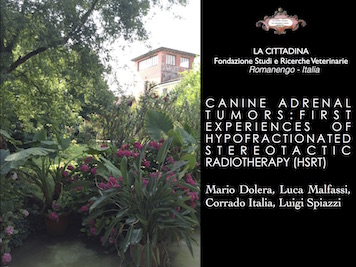CANINE ADRENAL TUMORS: FIRST EXPERIENCES OF HYPOFRACTIONATED STEREOTACTIC RADIOTHERAPY (HSRT)
Introduction/Purpose
The adrenal pathology is common in dogs. Surgical therapy is full of potential difficulties as well as internal medicine management. The purpose of this study was to evaluate the technical feasibility and therapeutic efficacy of ablation using hypofractionated stereotactic radiotherapy (HSR) in dogs.
The adrenal pathology is common in dogs. Surgical therapy is full of potential difficulties as well as internal medicine management. The purpose of this study was to evaluate the technical feasibility and therapeutic efficacy of ablation using hypofractionated stereotactic radiotherapy (HSR) in dogs.
Materials and Methods
5 dogs with adrenal tumor were treated using a LINAC with a micromultileaf collimator. All the patients were subjected to CT and MRI 3D simulation. The radiation therapy (RT) plans were computed using Monaco Volumetric Modulated Arc Therapy (VMAT) technique. Particular attention was given to the digestive tract, kydneys, spinal cord and pancreas. The RT plan has been evaluated to quality assessment dosimetry with DosimetryCheck software. The prescription dose was 30 Gy in 3 fractions. The follow-up have provided biochemical exams and CT/MRI.
5 dogs with adrenal tumor were treated using a LINAC with a micromultileaf collimator. All the patients were subjected to CT and MRI 3D simulation. The radiation therapy (RT) plans were computed using Monaco Volumetric Modulated Arc Therapy (VMAT) technique. Particular attention was given to the digestive tract, kydneys, spinal cord and pancreas. The RT plan has been evaluated to quality assessment dosimetry with DosimetryCheck software. The prescription dose was 30 Gy in 3 fractions. The follow-up have provided biochemical exams and CT/MRI.
Results
All patients completed the treatment plan. The cortisol reduction are the most significant laboratory findings, already evident after the second fraction and the tendency to a slight hyponatremia. The findings of CT/MRI are the progressive reduction in volume of the gland treated. Patients have reached the eucortisolemia over the first 2 months. At 12 months after treatment 4 patients were alive with good hormonal control, 1 patient was lost to unrelated causes.
All patients completed the treatment plan. The cortisol reduction are the most significant laboratory findings, already evident after the second fraction and the tendency to a slight hyponatremia. The findings of CT/MRI are the progressive reduction in volume of the gland treated. Patients have reached the eucortisolemia over the first 2 months. At 12 months after treatment 4 patients were alive with good hormonal control, 1 patient was lost to unrelated causes.
Discussion/Conclusion
The HSR may be an option in patients at high anesthetic risk or in case of vascular invasion. The transition to euendocrinia has been pretty smooth, but with rather rapid initial phase. We believe that the HSR merits further study in the treatment of adrenal tumors of the dog.
The HSR may be an option in patients at high anesthetic risk or in case of vascular invasion. The transition to euendocrinia has been pretty smooth, but with rather rapid initial phase. We believe that the HSR merits further study in the treatment of adrenal tumors of the dog.
